Moon Camp Explorers Gallery 2020-2021
In Moon Camp Explorers each team’s mission is to 3D design a complete Moon Camp using Tinkercad. They also have to explain how they will use local resources, protect astronauts from the dangerous of space and describe the living and working facilities.
Team: Star Girls
Międzynarodowa Szkoła Podstawowa Edukacji Innowacyjnej w Łodzi Łódź Poland 13, 8
External link for 3d
|
Project description
My lunar base is designed to keep astronauts alive and keep them safe. My base consists of several sectors: drilling, where dust is collected, which is sent to the collector, and ice, which, thanks to electrolysis, splits into oxygen and hydrogen. The second sector is the food sector, where there is a building where the food is produced. The third sector, i.e. the main base, where there are rooms for chemical, physical and biological research. A room where conversations with the Earth are conducted, on the roof of which there is an antenna enabling conversations. Data collection room (mainly from systems and detectors). There are also astronauts’ cabins and a place where astronauts take a nap during the day – the place from “Vinci Power Nap”. There is also a system place where the following systems are located: CReA, ECLSS, OGS. In the center of the main base, there is a daily meeting place for astronauts. In the Base, there are also landing sites, NBL, energy collectors, the energy of which is sent back to the Earth by a laser, there are also detectors: LLLTV (red strikes detector), seismic activity, ozone hole expansion and a radio wave detector. There is also a chlorofluorocarbons emitation room, which creates a natural ozone barrier after the emission of chemical compounds. The base has neutrinovoltaic panels and telescopes as well as rocket landing sites. |
|||
|
Where do you want to build your Moon Camp?
Close to the Lunar Poles Why did you choose this location?
I chose the visible side of the moon near the poles because craters near the poles could provide protection from solar winds. In addition, the base would be in continuous sunlight, which is needed if the energy is taken from the sun’s rays. Another important aspect for me was the smallest possible temperature fluctuations, which near the poles are much smaller than in the flat terrain. As far as landing is concerned, it is difficult there, but in the base there are flat places for rocket landing. How do you plan to build your Moon Camp? Which materials would you use?
I would use local products to build the base, such as: moon dust. I would like to build the base like this: After landing on the moon, the atronauts would expose to the surface of a 3D printer, the building material of which would be lunar dust, from which they would make buildings. Other devices would melt the dust in order to melt it and make it smooth and hard roads. However, if there were no such possibilities, the basic foundations of the base would be built of structures delivered from Earth. Then the dust would act as protection against radiation. Explain how your Moon Camp will provide the astronauts with:
|
|||
|
Water
|
Food
|
Electricity
|
Air
|
|
On the lunar base the ECLSS (Water Recovery System) will work. The water will be filtered, which will create a water circut at the Moon Camp. In addition, there are 2 drilling rooms in the base in which the ice is extracted, thanks to which astronauts will certainly have unlimited access to water. |
There will be a separate modular building at the Lunar Station built from geometric structures supplied in pieces from Earth. The crop material in the first planting attempts would have to be brought from Earth, but the waste could then be recycled to fertilize the soil. |
One source of energy would be a neutrinovoltaic – taking energy from neutrinos, molecules that fly through literally anything. Interestingly, using their properties, you can stack neutrino panels on top of each other – it saves a lot of space. Another form of this energy harvesting could be a solar power plant on the Moon, a huge plus is that the Moon has a synchronous rotation to the Earth (i.e. it is always facing the Earth in the same direction), so excess energy could be sent to Earth. |
There would be two systems operating on the Moonbase by which astronauts would have oxygen: |
|
Describe a day on the Moon for one of your Moon Camp astronauts
6:00 a.m. – getting up, bathing with a wet towel, getting dressed (all in the astronaut’s assigned rooms)
|
|||




